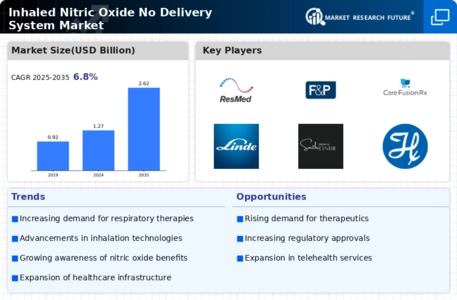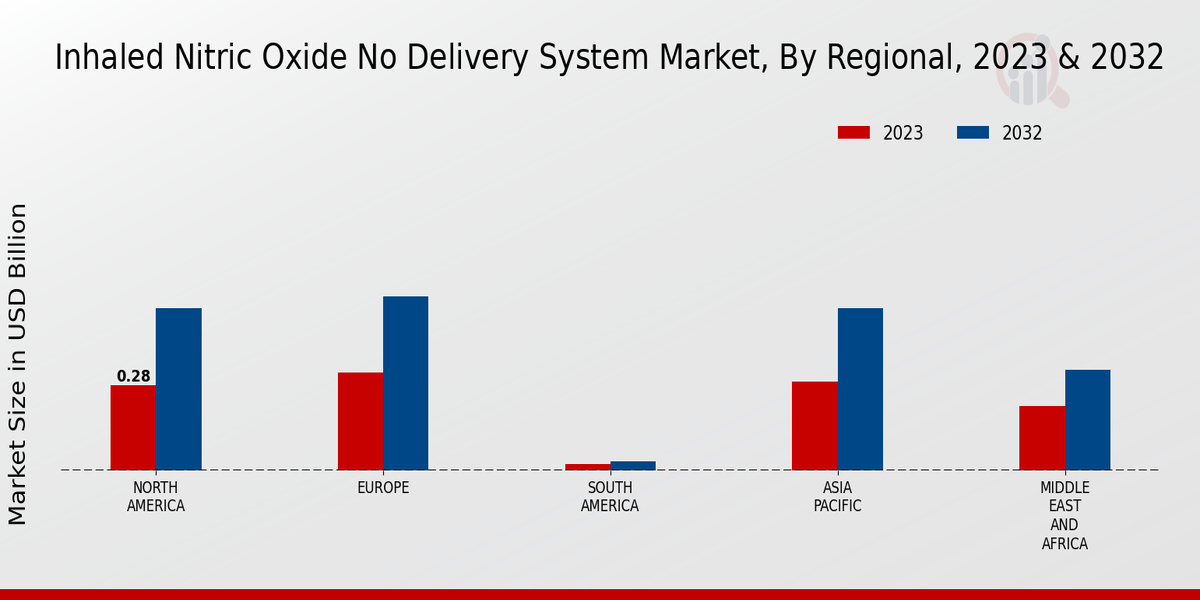Market Growth Projections
The Global Inhaled Nitric Oxide No Delivery System Market Industry is projected to experience substantial growth over the next decade. With an estimated market value of 1.27 USD Billion in 2024, it is anticipated to reach 2.62 USD Billion by 2035, reflecting a compound annual growth rate of 6.79% from 2025 to 2035. This growth is indicative of the increasing demand for effective treatments for respiratory disorders and the ongoing advancements in inhaled nitric oxide delivery systems. The market's trajectory suggests a robust future, driven by technological innovations and rising healthcare investments.
Regulatory Support and Approvals
Regulatory bodies are increasingly supporting the use of inhaled nitric oxide therapies, which is positively impacting the Global Inhaled Nitric Oxide No Delivery System Market Industry. Recent approvals for new formulations and delivery systems are facilitating market entry for innovative products. This regulatory support not only enhances the credibility of nitric oxide therapies but also encourages manufacturers to invest in research and development. As a result, the market is likely to expand, driven by the introduction of new and improved delivery systems that meet regulatory standards.
Growing Awareness of Nitric Oxide Therapy
There is a growing awareness among healthcare professionals and patients regarding the benefits of nitric oxide therapy in treating respiratory conditions. Educational initiatives and clinical guidelines are emphasizing the role of inhaled nitric oxide in improving patient outcomes. This increased awareness is likely to drive demand within the Global Inhaled Nitric Oxide No Delivery System Market Industry, as more practitioners recognize its potential in managing severe pulmonary hypertension and other related disorders. As a result, the market is expected to witness a compound annual growth rate of 6.79% from 2025 to 2035.
Rising Prevalence of Respiratory Disorders
The Global Inhaled Nitric Oxide No Delivery System Market Industry is experiencing growth due to the increasing prevalence of respiratory disorders such as asthma and chronic obstructive pulmonary disease. According to health statistics, respiratory diseases account for a significant portion of global morbidity and mortality. The demand for effective treatment options is rising, leading to a greater adoption of inhaled nitric oxide therapies. This trend is expected to drive the market, as inhaled nitric oxide has shown efficacy in improving oxygenation and reducing pulmonary hypertension in patients with these conditions.
Technological Advancements in Delivery Systems
Technological innovations in the Global Inhaled Nitric Oxide No Delivery System Market Industry are enhancing the efficacy and safety of nitric oxide delivery. Newer devices are being developed that allow for more precise dosing and better patient compliance. These advancements are crucial as they improve treatment outcomes for patients with severe respiratory conditions. The integration of smart technologies, such as real-time monitoring and automated dosing, is likely to attract healthcare providers and patients alike, thereby expanding market opportunities. As a result, the market is projected to grow significantly in the coming years.
Increasing Investment in Healthcare Infrastructure
The Global Inhaled Nitric Oxide No Delivery System Market Industry is benefiting from increased investments in healthcare infrastructure, particularly in developing regions. Governments and private sectors are focusing on enhancing healthcare facilities and expanding access to advanced medical technologies. This investment is likely to facilitate the adoption of inhaled nitric oxide therapies, as healthcare providers seek to implement effective treatment options for respiratory disorders. With the market projected to reach 1.27 USD Billion in 2024 and 2.62 USD Billion by 2035, the growth trajectory appears promising.




















Leave a Comment